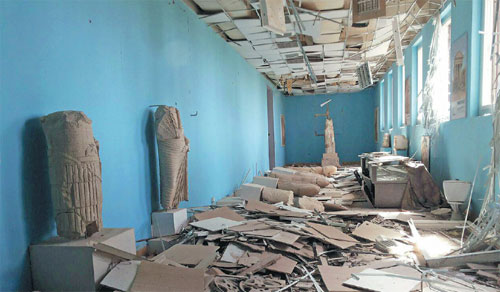Antiquities experts rush to Palmyra after govt ousts IS
Extremist group sparked a global outcry when it started destroying treasured monuments
Archaeologists were rushing to the ancient city of Palmyra on Monday to assess the damage wreaked by the Islamic State group, after it was ousted by the Syrian army in a bloody battle.
Syrian President Bashar al-Assad hailed the victory as "important" as Damascus reportedly dispatched experts to check the damage wreaked by the jihadists on the UNESCO world heritage site.
An AFP correspondent inside Palmyra said some monuments, including the iconic Temple of Bel, lay in pieces almost a year after jihadists seized the site, but much of the ancient city was intact.
Residential neighborhoods in the adjacent modern town, where 70,000 people lived before the war, were deserted and amage there was widespread, the correspondent said.
Syrian soldiers and pro-government militiamen strolled among the ruins in awe after seizing the city on Sunday, while government troops kicked around a football in the middle of a street.
The Islamic State group sparked a global outcry when they started destroying Palmyra's treasured monuments, which they consider idolatrous, after taking the city in May 2015.
Syria's antiquities chief said the priceless artifacts had survived better than feared from a campaign of destruction UNESCO described as a "war crime".
"We were expecting the worst. But the landscape, in general, is in good shape," Maamoun Abdulkarim said in Damascus.
"We could have completely lost Palmyra. ... The joy I feel is indescribable."
Historian of the ancient world Maurice Sartre said that Abdulkarim was already on his way from Damascus to begin a survey of the ruins.
"One mustn't forget that only around 15 to 20 percent of Palmyra had actually been excavated, and so there was an enormous amount yet to discover," he said.
"All the tombs we hadn't excavated and have now been totally pillaged are lost to science forever."
Venue for executions
IS had used Palmyra's ancient theater as a venue for public executions and also murdered the city's 82-year-old former antiquities chief.
The Syrian army said the city would now serve as a base to "broaden operations" against IS, including in its stronghold of Raqa and Deir Ezzor further east.
At least 400 IS fighters were killed in the battle for the city, the Syrian Observatory for Human Rights said. On the government side, 188 troops and militiamen were killed.
"That's the heaviest losses that IS has sustained in a single battle since its creation" in 2013, said the director of the Britain-based monitoring group, Rami Abdel Rahman.
The ancient city, northeast of Damascus, drew some 150,000 tourists a year before Syria's civil war and is known to Syrians as the "Pearl of the Desert".
Syrian state television broadcast footage from inside Palmyra's famed museum, showing jagged pieces of sculptures on the ground and blanketed in dust.
IS is under growing pressure from Syrian and Iraqi forces determined to retake bastions of its self-proclaimed "caliphate".
On Thursday, the Iraqi army announced the launch of an offensive to eventually recapture second city Mosul, held by the jihadists since June 2014.
|
Damaged relics inside the museum in the historic city of Palmyra, after government forces recaptured the city, in Homs Governorate, on Sunday. Syrian Arab News Agency Via Reuters |



















